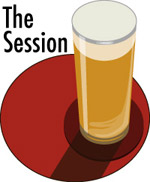 I have at this moment a deep and abiding thirst for something called a narfer narfer narf.
I have at this moment a deep and abiding thirst for something called a narfer narfer narf.
You see, the topic for today’s 88th gathering of The Session is traditional beer mixes. In making the announcement, hosts Boak & Bailey list several options from Richard Boston’s “Beer and Skittles.” The choices appear in a chapter titled “The Public House” and although the book predates Sierra Nevada Brewing by only a few years (1976 versus 1980) it describes a world that seems more like a setting for an HBO series than one you find in these parts.
Consider a few words from the chapter:
1 The quest
All the pub’s a stage, and all the men and women merely players. Everything about a pub is theatrical: the exits and the entrances, the dialogue, the eating and drinking, the games. … Opening time and closing time even give each session the dramatic structure of beginning, middle and end postulated by Aristotle as necessary to a well-made play.
2 The people
… then there’s the Why-my-wife-left me bore, the Send-them-back-to-Ireland/West Indies bore, the useless information bore. The drinks bore is one of the worst …
Boston discusses choices of drinks within this context. Although it might appear on the surface I could settle in at the bar at a nearby establishment with a considerable number of beer options my chances of ending up with anything similar to a granny (mixing old and mild) or blacksmith (stout and barley wine) Boston might recognize pretty much don’t exist. Even though finding stouts and barley wines is easy. Beer at AnyplaceinAmerica in 2014 has about as much to do with beer in Boston’s England in 1976 as beer and ale had to do with each other in England in 1542.
And a narfer narf, half a pint of mild and half a pint of bitter? Get serious. (A narfer narfer narf is half a pint of the mixture.)
Recognizing this reality, that I would not be writing about actually drinking narfer narfer narf, Tuesday night at Busch Stadium I decided to try a ballpark blend. Before emptying my plastic cup of Urban Chestnut Schnickelfritz, which remains about the perfect 90 degree/90% humidity ballpark beer, I mixed the remainder with an equal part of Schlafly Pale Ale. I did not wake up Tuesday morning wondering what flavors I’d find if I cut Schnickelfritz with Pale Ale. I chose these two because they are the ones I drink most often at the ballpark. They are local and they are refreshing. I like that combination. I suppose there was a little more, or at least different, fruity character in the blend. More hops, for sure, than Schnickelfritz alone, earthier. But mostly refreshing, and better so because they were brewed locally by other people who live in St. Louis.
(Understand that I grew up in central Illinois, not St. Louis, rooting for the Chicago Cubs, and therefore against the Cardinals. They now serve Goose Island Honker’s Ale and IPA at Busch, beers I really like that originated in Chicago although they are now brewed elsewhere. But at a baseball game in St. Louis I’m drinking a St. Louis-made beer. Once in a while Boulevard Wheat, which is also brewed by people who pay the same state taxes I do, but not Tuesday, even though the Cardinals were playing the Royals. I am not arguing this allegiance to local is rational, but it is real.)
Finally, an aside. I could have done my blending at the Budweiser Brew House at recently opened Ballpark Village. You can actually watch a game from a deck in the Brewhouse (sort of like the Wrigley Field rooftops). They’ve got maybe all of the A-B Inbev beers sold in the U.S. on tap somewhere within the complex. By chance, taps for Goose Island Matilda and Faust, an A-B throwback beer, are side by side. That was probably a missed blending opportunity, you think?
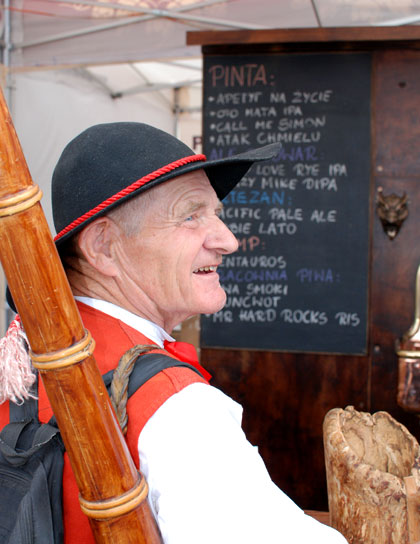
 So you bought the first edition of
So you bought the first edition of 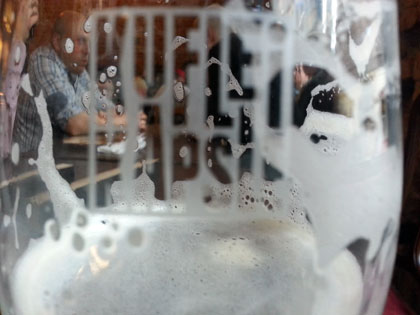
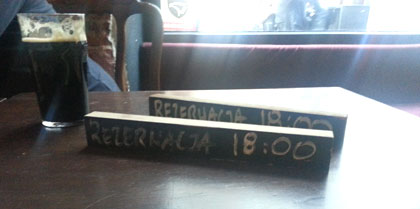

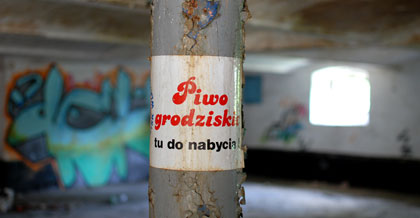
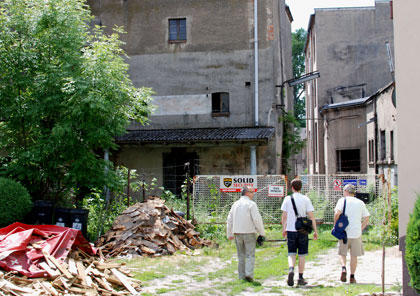
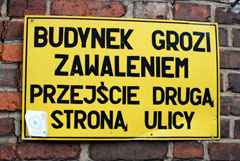 Grodzisk, home to about 14,000 people, is totally charming. Bochyński led us past three buildings in other parts of town that were once breweries. Grodzisk had 53 at the end of the eighteenth century and still five, all much bigger and selling their beer in far away posts, at the beginning of the twentieth. The warning sign to the right — Jan explained it basically says to stand away from the building because it is in danger of collapsing — is posted on the side of one of them.
Grodzisk, home to about 14,000 people, is totally charming. Bochyński led us past three buildings in other parts of town that were once breweries. Grodzisk had 53 at the end of the eighteenth century and still five, all much bigger and selling their beer in far away posts, at the beginning of the twentieth. The warning sign to the right — Jan explained it basically says to stand away from the building because it is in danger of collapsing — is posted on the side of one of them.  I’m not sure standing in the middle of this brewery in waiting if it is easier to envision what it once looked like or what it will look like. Jan shook his head as we walked away, saying he couldn’t believe they’d be brewing only months from now. But it turns out he hasn’t visited Browar Fortuna, about 100 kilometers to the east, recently. There the same four principals involved in Grodzisk have modernized a regional brewery that was slowly grinding to a halt.
I’m not sure standing in the middle of this brewery in waiting if it is easier to envision what it once looked like or what it will look like. Jan shook his head as we walked away, saying he couldn’t believe they’d be brewing only months from now. But it turns out he hasn’t visited Browar Fortuna, about 100 kilometers to the east, recently. There the same four principals involved in Grodzisk have modernized a regional brewery that was slowly grinding to a halt.  I have at this moment a deep and abiding thirst for something called a narfer narfer narf.
I have at this moment a deep and abiding thirst for something called a narfer narfer narf.